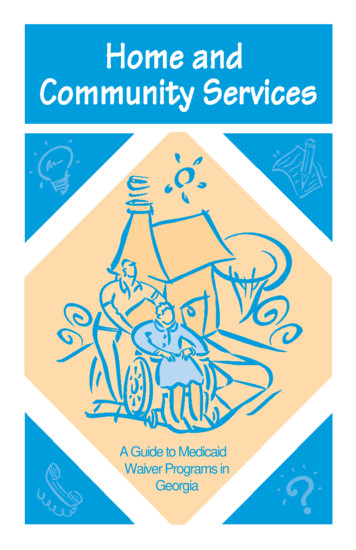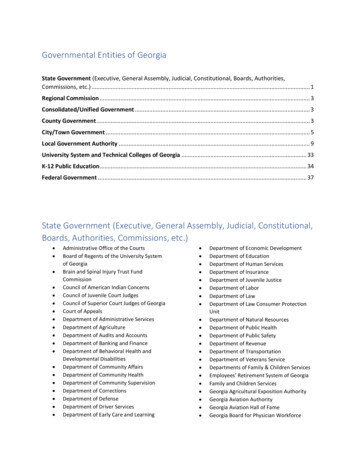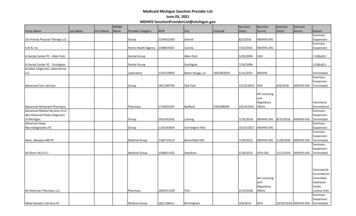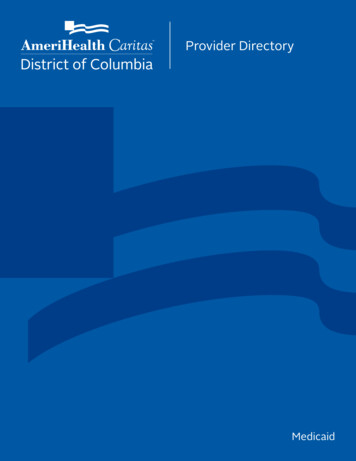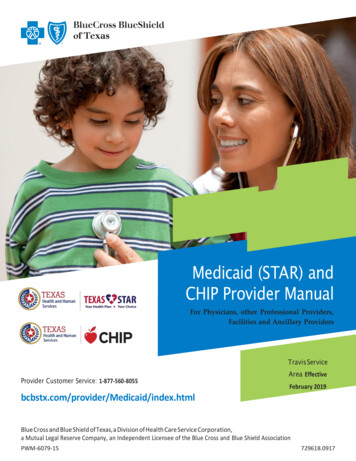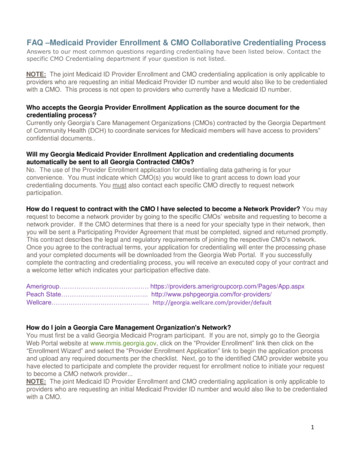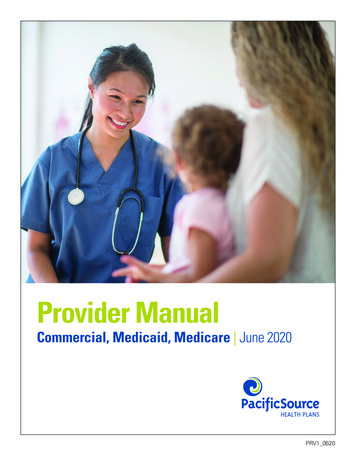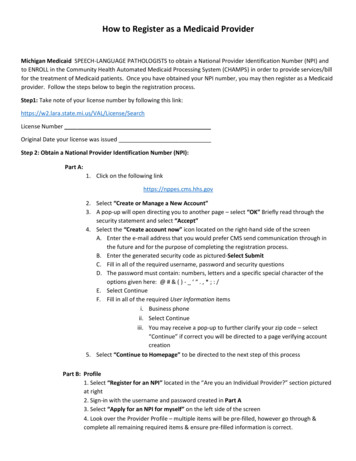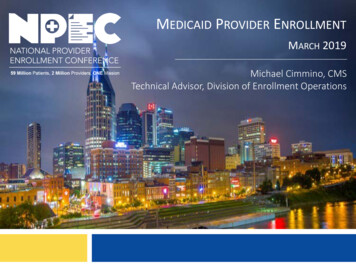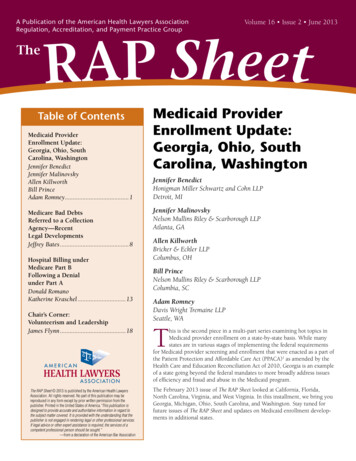
Transcription
A Publication of the American Health Lawyers AssociationRegulation, Accreditation, and Payment Practice GroupTheVolume 16 Issue 2 June 2013RAP SheetTable of ContentsMedicaid ProviderEnrollment Update:Georgia, Ohio, SouthCarolina, WashingtonJennifer BenedictJennifer MalinovskyAllen KillworthBill PrinceAdam Romney. 1Medicare Bad DebtsReferred to a CollectionAgency—RecentLegal DevelopmentsJeffrey Bates. 8Hospital Billing underMedicare Part BFollowing a Denialunder Part ADonald RomanoKatherine Kraschel. 13Chair’s Corner:Volunteerism and LeadershipJames Flynn. 18The RAP Sheet 2013 is published by the American Health LawyersAssociation. All rights reserved. No part of this publication may bereproduced in any form except by prior written permission from thepublisher. Printed in the United States of America.“This publication isdesigned to provide accurate and authoritative information in regard tothe subject matter covered. It is provided with the understanding that thepublisher is not engaged in rendering legal or other professional services.If legal advice or other expert assistance is required, the services of acompetent professional person should be sought.”—from a declaration of the American Bar AssociationMedicaid ProviderEnrollment Update:Georgia, Ohio, SouthCarolina, WashingtonJennifer BenedictHonigman Miller Schwartz and Cohn LLPDetroit, MIJennifer MalinovskyNelson Mullins Riley & Scarborough LLPAtlanta, GAAllen KillworthBricker & Eckler LLPColumbus, OHBill PrinceNelson Mullins Riley & Scarborough LLPColumbia, SCAdam RomneyDavis Wright Tremaine LLPSeattle, WAThis is the second piece in a multi-part series examining hot topics inMedicaid provider enrollment on a state-by-state basis. While manystates are in various stages of implementing the federal requirementsfor Medicaid provider screening and enrollment that were enacted as a part ofthe Patient Protection and Affordable Care Act (PPACA)1 as amended by theHealth Care and Education Reconciliation Act of 2010, Georgia is an exampleof a state going beyond the federal mandates to more broadly address issuesof efficiency and fraud and abuse in the Medicaid program.The February 2013 issue of The RAP Sheet looked at California, Florida,North Carolina, Virginia, and West Virginia. In this installment, we bring youGeorgia, Michigan, Ohio, South Carolina, and Washington. Stay tuned forfuture issues of The RAP Sheet and updates on Medicaid enrollment developments in additional states.
T heRAP SheetNew Resource for Enrollment GuidanceDCH has posted on its website as of November 2011 a new,detailed frequently asked questions compilation designed to facilitate the enrollment process for providers. The guidance walksproviders through the enrollment process and provides links torelated ancillary information needed to complete the application. It also provides important information to enrolled providersregarding the change-of-ownership process and changing electronic funds transfer payee.Redesign of Georgia MedicaidIn 2011, DCH engaged Navigant Consulting to undertake acomprehensive assessment of Georgia’s Medicaid program and toidentify options for redesign.6 In July 2012, DCH announced thatwhile it was not undertaking a wholesale redesign of the Medicaidprogram given the then-continued uncertainty of healthcare initiatives at the federal level, it was implementing certain key recommendations, including: (1) continued use of the care managementorganization (CMO) model to serve Medicaid and PeachCare forKids populations; (2) transitioning foster children to a singledesignated CMO; and (3) implementing a value-based purchasingmodel.7 Of particular interest to providers will be DCH’s initiativeto create a centralized portal designed to reduce administrativeburdens and make it easier for providers to care for their patientsby giving providers more comprehensive, accurate, and timelyinformation about their patients, streamlining the credentialingprocess, providing key performance metrics, and designating areasfor improvement. With respect to credentialing specifically, theintent is to provide an avenue for new Georgia Medicaid providerswishing to participate in a CMO to file a single-source applicationand share credentialing information with each of the CMOs.8GeorgiaAs Georgia has sought both to position itself for compliance withvarious mandates of PPACA and address the dynamic healthcareregulatory environment at the state level, the Georgia Departmentof Community Health (DCH), the state agency that administersthe Medicaid program in Georgia, has, over the past couple ofyears, implemented several new initiatives impacting Medicaidstakeholders, including beneficiaries, providers, communities, and governmental agencies.2 Several of these initiatives aredesigned to directly improve the administration and efficiency ofthe Medicaid provider enrollment process, and at the same time,more closely monitor potential fraud and abuse in the Medicaidprogram and enhance the ability of physicians to provide morecomplete patient care through information availability andsharing measures. While not an exhaustive list, following are afew key items of note Georgia has undertaken:Medicaid Provider Enrollment SectionIn early 2011, DCH transferred the Provider EnrollmentSection from DCH’s Office of the General Counsel to the Officeof Inspector General (OIG). This change will, in part, enableDCH to better control fraud in the Medicaid/PeachCare for Kidsprograms by monitoring providers from the time of actual enrollment in the Medicaid program. To that end, the Provider Enrollment Section is implementing several new initiatives includingbackground screening processes, enhanced database checks, andre-enrollment of providers every three years.3Electronic Provider EnrollmentDCH has implemented an electronic enrollment process that hasserved to reduce the application processing time from severalmonths to a couple of weeks, resulting in an increased numberof providers throughout the state and a reduction in administrative challenges faced by providers.4 Financial investmentin advanced information technology systems is a fundamentalnecessity for states in order to streamline their eligibility andenrollment processes, which will impact (and benefit) bothpatients and providers.5MichiganProvider Screening and EnrollmentMichigan, like other states, is implementing new Medicaidprovider screening and enrollment requirements, as required byPPACA. Highlights of these new requirements are described below.2
urgent care centers (UCCs), physician assistants (PAs), and nursepractitioners (NPs).Additional screening of Medicaid providers will be conductedbased on the provider’s categorical risk level.9 The higher therisk level, the more robust the screening activities will be. TheMichigan Department of Community Health (MDCH), whichadministers the Medicaid program in Michigan, adopted therisk categorization established by the Centers for Medicare &Medicaid Services (CMS) for provider types recognized under theMedicare program.10 For non-Medicare provider types, MDCHestablishes the risk level.With respect to UCCs, MDCH identified a need to improve accessto non-emergency services for Medicaid beneficiaries.15 MichiganMedicaid defines a UCC as “a medical clinic or office, not locatedin a hospital emergency department, whose purpose is to provideunscheduled diagnosis and treatment of illnesses for ambulatorybeneficiaries requiring immediate medical attention for nonlife-threatening conditions.”16 Enrollment of UCCs is expectedto provide access to a place of service more appropriate thana hospital emergency room when a beneficiary’s primary careprovider is not available. Enrollment for UCCs began on October1, 2012.17There are three risk categories—“high,” “moderate,” and“limited.” Provider types in the high-risk category, and thussubject to the most rigorous screening requirements, are newlyenrolling home health agencies and durable medical equipment, prosthetics, orthotics, and supplies (DMEPOS) suppliers.Screening activities for providers in the high-risk category includeunannounced site visits and fingerprint-based criminal background checks.11Also beginning October 1, 2012, licensed PAs and NPs whorender, order, or bill for covered services to Medicaid beneficiaries must begin enrolling in Medicaid.18 As of January 1, 2013,PAs and NPs will no longer bill for services under their delegating/supervising physician’s NPI.19 Rather, NPs and PAs mustenroll with an Individual (Type 1) NPI number as a rendering/servicing-only provider.20Provider types in the moderate-risk category are ambulanceservices, community mental health centers, comprehensiveoutpatient rehabilitation facilities, hospice organizations, independent clinical laboratories, physical therapists, revalidatinghome health agencies, and DMEPOS suppliers.12 While MDCHdoes not contemplate criminal background checks for providersin the moderate-risk category at this time, they will be subject tounannounced site visits. All other provider types not in the highor moderate-risk categories, such as hospitals and nursing homes,are in the limited-risk category. Screening requirements for thelimited-risk category include verification of licensure, SocialSecurity number, Taxpayer Identification Number, NationalProvider Identifier (NPI), and OIG exclusion status.PAs and NPs must affiliate themselves with the billing NPI oftheir delegating/supervising physician, and payment for servicesprovided by NPs and PAs will be paid to the affiliated delegating/supervising physician, group, or billing provider NPI.21 However,the enrollment procedures and requirements for NPs who renderservices pursuant to a formal, written collaborative practice agreement with a physician remain unchanged. These enrolled NPs areeligible for direct payment for NP services provided.22All providers enrolling in Medicaid, except for individual physicians and non-physician practitioners, are now required to pay anapplication fee. The fee, which is established by CMS and is 523for 2012, will be updated annually; however, providers whoare enrolled in or have paid the application fee to Medicare oranother state’s Medicaid or Children’s Health Insurance Programare not required to pay the application fee. Also, providers mayrequest a hardship exception from MDCH.13Providers enrolled in Medicaid will be required to revalidate theirMedicaid enrollment information every five years, unless MDCHrequires revalidations more frequently. MDCH will contactproviders when it is time to revalidate. Medicaid providers shouldcontinue to notify MDCH within 35 days of any change to theirenrollment information.14 Revalidation does not change therequirement to provide MDCH with notice of such changes.OhioMDCH will provide updates as these new screening and enrollment requirements are implemented.The Ohio Department of Job and Family Services (ODJFS), thestate agency responsible for the Ohio Medicaid program, hasimplemented various new regulations in 2012 and is in theprocess of promulgating additional regulations in 2013 to complywith the PPACA requirements for Medicaid provider screeningand enrollment.Enrollment of Urgent Care Centers, PhysicianAssistants, and Nurse PractitionersIn addition to the changes in provider enrollment and screeningdiscussed above, Medicaid is now enrolling new provider types—3
T heRAP SheetEnrollment Screening LevelsEnrollment Application FeesODJFS has already implemented regulations, effective as of March31, 2012,23 to classify providers into limited, moderate, and highcategorical risks, as required by PPACA.24 The category levelsreflect the level of enrollment scrutiny to be used for providers inthat category. Providers in the limited category are subject to:(1) verification that they meet any applicable Medicaid requirements for their provider type; (2) license verifications, includingstate licensure verification in states other than Ohio; and(3) database checks on a pre-enrollment and post-enrollmentbasis to ensure that providers continue to meet the enrollment criteria for their provider type. Providers in the moderatecategory are subject to: (1) all of the requirements for the limitedcategory; and (2) onsite visits, including pre-enrollment andpost-enrollment site visits as well as unannounced onsite inspections. Providers in the high category are: (1) subject to all of therequirements for the limited and moderate categories; and(2) each person with a 5% or greater ownership or controlinterest in the provider is subject to a criminal background checkand required to submit fingerprints to ODJFS.25 To be an eligibleprovider in the Medicaid program, the provider must meet theapplicable screening requirements.26 However, the regulationprovides that a provider is exempt from this regulation if theprovider participates in the Medicare program and has met theMedicare provider screening requirements or if the providerhas met screening requirements for another state’s Medicaidprogram.27Effective March 31, 2012, providers will be required to pay anenrollment fee of 532 at the time of initial enrollment and everyfive years at the time of revalidation.32 A provider must have paidthis application fee to be an eligible provider in the Medicaidprogram.33 However, the fee is not required from providers thatare enrolled in Medicare or that have paid an enrollment fee inanother state’s Medicaid program.34South CarolinaSouth Carolina began implementation of the changes inprovider enrollment mandated by PPACA in August 2012.These changes were finalized in the revised Provider EnrollmentManual published on December 3, 2012, and can be accessedon the South Carolina Department of Health & Human Services(SCDHHS) website at www.scdhhs.gov.RevalidationUnder current regulations, Medicaid provider agreements maybe term limited to seven years.28 To comply with the PPACArequirement that Medicaid programs revalidate the enrollmentof all providers at least every five years,29 ODJFS has indicatedthat it will revise these regulations in 2013 to require revalidationevery five years, presumably by shortening the maximum lengthof term-limited provider agreements. The current regulationalso allows for open-ended provider agreements and specifically provides that hospitals, nursing facilities, intermediate carefacilities, and managed care organizations utilize open-endedprovider agreements.30 It is unclear if these open-ended provideragreements will continue to exist subject to revalidation screeningrequirements or if these open-ended provider agreements will beconverted to term-limited provider agreements.MoratoriaSCDHHS has imposed a temporary moratorium on the enrollment of providers identified as being an increased risk to theMedicaid program by the Secretary of HHS. SCDHHS may alsoimpose a temporary moratorium on new providers or imposenumerical caps, or other limits on providers the state identifiesas having a significant potential for fraud, waste, or abuse. Themoratorium would be for six months and could be extended insix-month increments if documented in writing.35Ordering or Referring ProviderSCDHHS now requires that all ordering or referring physiciansor other professionals providing services under the state plan orany waiver shall be enrolled as participating providers. Qualifiedproviders must be enrolled in South Carolina Medicaid to orderor refer services or to bill Medicaid for these services. Ordering orreferring providers must submit an application, pay appropriateapplication fees, and be subject to the same screening process asall providers.36Requirements for Enrollment of Ordering andReferring PhysiciansPreviously, ordering and referring physicians did not have tobe enrolled in the Medicaid program in Ohio. To satisfy PPACArequirements,31 ODJFS will require all ordering and referringphysicians and other professionals providing services underthe Ohio Medicaid program to become enrolled as Medicaidproviders and go through the enrollment and screening process.4
Enrollment ScreeningWashingtonAll providers must be screened by SCDHHS prior to enrollment.The level and type of screening will be based on a categoricalrisk level of limited, moderate, or high. Limited-risk providersmust be in good standing with their licensing board and meetall provider-specific requirements. Moderate-risk providers mustmeet all standards for limited-risk providers, and agree to anonsite visit by SCDHHS. High-risk providers must meet all standards for limited- and moderate-risk providers, and undergo acriminal background check and submit fingerprinting. SCDHHSwill adjust the categorical risk level from limited or moderate tohigh if one of the following applies:Washington has adopted, and continues to develop new Medicaidprovider enrollment rules to implement online enrollmentcapabilities, screen out fraudulent providers upon enrollment orduring revalidation, and increase oversight over ordering, referring, and prescribing providers. The following are some of thesignificant new enrollment measures adopted into the Washington Medicaid program this year.New Proposed Enrollment Screening RulesOn December 5, 2012, the Washington State Health CareAuthority (HCA) released proposed rules that would requireapplicants to undergo more intensive screening procedureswhen initially enrolling in the Medicaid program.40 If adopted,the new rules would require new provider applicants to disclosedetailed information regarding their direct and indirect owners,employees who manage their organization, as well as others whohave the ability to exert control over the organization.41 Applicants would also be subject to new and additional enrollmentscreening requirements such as license verifications, databasechecks, site visits, and criminal background checks includingfingerprint-based criminal background checks for those providersconsidered high risk for potential fraud and abuse by Medicare.42 The proposed rules would also grant HCA the authority toimpose temporary moratoria on the enrollment of new Medicaidproviders when either directed or approved by CMS.43 Payment suspension occurs based on a credible allegation ofwaste, fraud, or abuse; The provider has an existing Medicaid overpayment; The provider has been excluded from another Medicaidprogram within the past 10 years; or An enrollee was under a temporary moratorium within themost recent six months.South Carolina will conduct both pre- and post-enrollment onsitevisits for providers deemed moderate- or high-risk providers.37RevalidationAll providers, except DME providers, must have their enrollmentinformation revalidated every five years. DME providers musthave their enrollment information revalidated every three years.Providers seeking revalidation must submit a new applicationand pay a new application fee to continue enrollment in SouthCarolina Medicaid. Failure to meet these requirements will resultin termination.38New Revalidation RequirementsThe proposed rules released on December 5, 2012 would alsointroduce new provider revalidation procedures into the Washington Medicaid program. The proposed rule would subjectenrolled providers to a revalidation process at least every fiveyears.44 The revalidation process would include, but not necessarily be limited to, updating provider enrollment information,submitting any specific forms required by HCA, and undergoingHCA screening protocol for new providers as described above.45Criminal Background ChecksAs a condition of enrollment, all providers must consent to acriminal background check, including federal and state databases,if:New Requirements for Ordering, Referring, andPrescribing Providers They have 5% or more ownership interest in the provider; or They are listed in the moderate
The Ohio Department of Job and Family Services (ODJFS), the state agency responsible for the Ohio Medicaid program, has implemented various new regulations in 2012 and is in the process of promulgating additional regulations in 2013 to comply with the PPACA requirements for Medicaid pro
